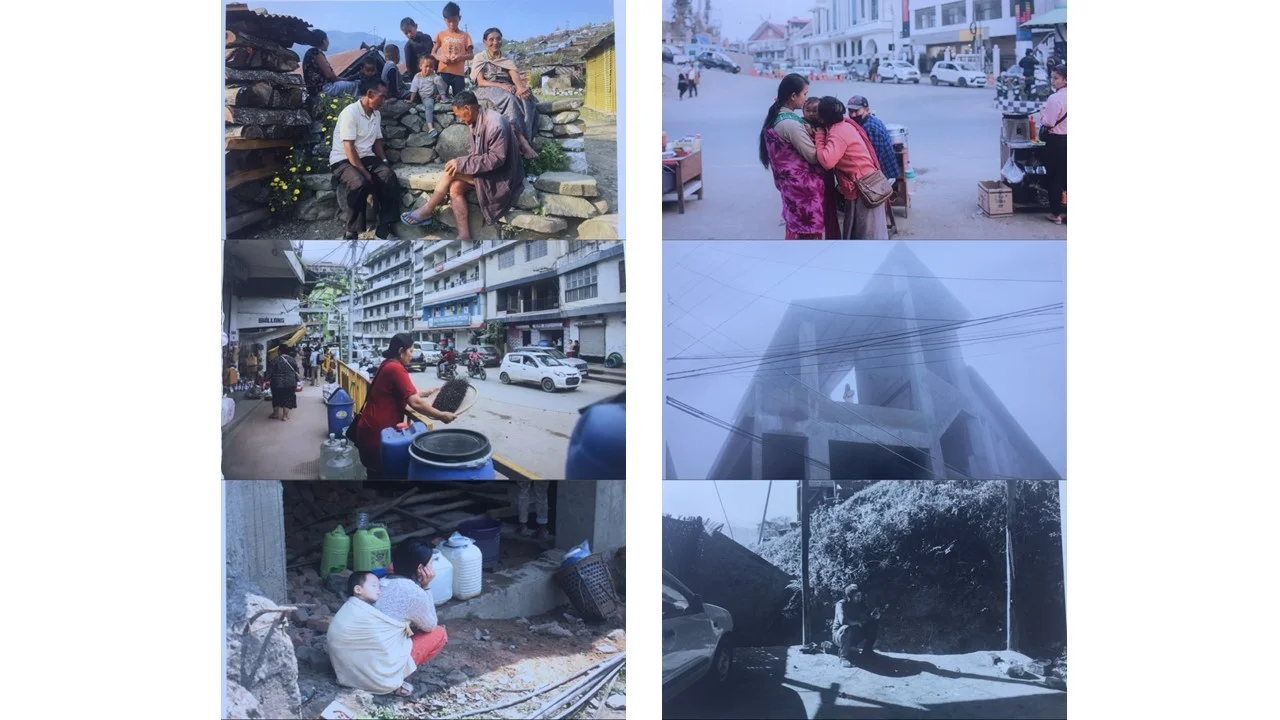During the last few days in Kohima, visitors passing through the Box Cutting area would have come across a range of large-sized photographs lining up the wire frames and archways of the footpath.
Amidst the busy activities of the Hornbill festival mainly concentrated in Kisama, a quiet little photo exhibition was held for six days at Box Cutting Footpath, just behind Kohima War Cemetery.
Running from 5 to 10 December, Home Exhibition featured the work of four photographers: Kekhriezhazo Miachieo, Seyie Suohu, Albert Rutsa and Rajat Limbu.
Kekhriezhazo (Zhazho) Miachieo’s work focuses on human interest and environmental portraits. Seyie Suohu’s interest lies in documentary and storytelling photography focusing on Eastern Nagas. Albert Rutsa captures culture and traditions of the Nagas. Rajat Limbu, photographer and video journalist, documents the streets and people of Kohima.
The four are also the organisers of the Home Exhibition, with this year’s event being the second edition.

Home Exhibition at Box Cutting Footpath in Kohima.
Zhazo Miachieo, whose latest project is on documenting the life of the Nagas and how the past traditions interlink with the lifestyle of present times, spoke with Nagaland Tribune on the Home Exhibition, the inspiration behind it and the work of the photographers involved.
Following are the edited excerpts.
Nagaland Tribune: How did this exhibition come about?
Zhazo Miachieo: The first edition of the exhibition was in 2019. A group of four independent photographers came together and discussed about organising an exhibition. It was a self-funded exhibition. It was difficult as well as we were not planning to sell our photography. We just wanted people to come and see and experience the emotions that we felt by photographing those pictures through our subjects.
The exhibition was for the masses and not for sale or any financial benefits but for people to come and appreciate life through our works. So, we took on the challenge. It was difficult because we didn’t know how the crowd would respond but somehow it was very well received. However, we couldn’t do a follow up because of the pandemic.
NT: Why is it called Home Exhibition?
ZM: We called our exhibition Home to show how each photographer has tried to explore the figures that make a home in their photographs, in their imagination, in their hopes and fears and emotions. Home is a photographic expression into life, society and human nature.

The exhibition explored the concept of home through the eyes of four photographers.
NT: How do you go about choosing the themes for the exhibition?
ZM: We have kept the exhibition’s theme as Home for the past two editions because there are so many aspects that we can do to explore through this title.
Each photographer has their own way of understanding about home and how they can interpret home through their pictures. So, we thought of keeping it simple with a vast title.
NT: When was the first exhibition held?
ZM: The first exhibition was held at D Cafe from 1 to 10 December in 2019.
NT: Who are the participants of the exhibition? How do you collect the images and what are the stories of the photographs?
ZM: We have been taking pictures for some time now so we curated the images that we have based on our theme ‘Home’. The stories of these photographs are all different.
One of the photographers is one of the few street photographers in Kohima. He has been photographing the streets of Kohima for the past five years. You can see how he was able to take beautiful image compositions out of the mundane life, out of the ordinary. He has serious eyes and impeccable timing in the act of taking such beautiful images of the things that we see and cross every day.
We have another photographer who focuses on the tradition and culture of our tribe especially the Angamis and how it interacts with the lifestyle brought about by the development and advancement of technology.

The organisers of Home Exhibition.
We have a documentary photographer whose work focuses on the Eastern Nagas – how development has been deprived in their regions and how that affects the lifestyle of the people there trying to survive let alone living.
We have another photographer whose work focuses on his aunt and uncle. For five years, he has been taking photos of their marriage experience – the struggles they had together but how they still overcame their differences, struggles and obstacles by keeping love as their centre piece.
If viewers can come and, through the images, get something out of it and feel the emotions that we felt and if they can appreciate life, I guess the exhibition serves its purpose.

Home is a photographic expression into life, society and human nature – Zhazo Miachieo.
NT: Have you faced any challenges along the way?
ZM: We have had many challenges for this exhibition. The main one was monetary because the first exhibition was self-funded. For the second exhibition, we presented the idea of our exhibition to the department of Information & Public Relations and they were kind enough to give us some assistance. Also, KMC (Kohima Municipal Council) gave us the space that we are using now for the exhibition. We are very grateful to the authorities as well.
NT: How has your overall experience of organising the Home Exhibition been?
ZM: The experience is good. There’s hardly any photo exhibition here in Nagaland. The way we printed our exhibition, the way we mounted – we learnt so many things along the way. We made mistakes as well but it’s a collective effort from all the four photographers and from the authorities as well, so we are very grateful to everyone for this exhibition.


